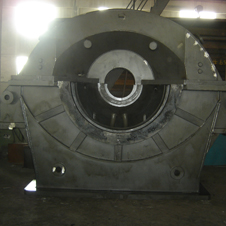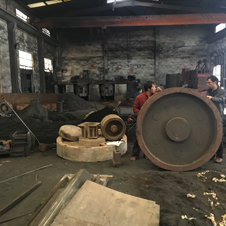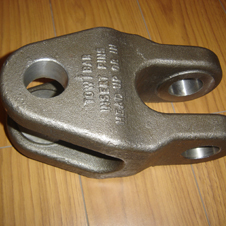
Casting
- Aluminum Die-casting
- Steel Investment casting
- Iron Sand Casting
Die casting is a metal casting process that is characterized by forcing molten metal under high pressure into a mold cavity. The mold cavity is created using two hardened tool steel dies which have been machined into shape and work similarly to an injection mold during the process. Most die castings are made from non-ferrous metals, specifically zinc, copper, aluminium, magnesium, lead, pewter, and tin-based alloys. Depending on the type of metal being cast, a hot- or cold-chamber machine is used.
The casting equipment and the metal dies represent large capital costs and this tends to limit the process to high-volume production. Manufacture of parts using die casting is relatively simple, involving only four main steps, which keeps the incremental cost per item low. It is especially suited for a large quantity of small- to medium-sized castings, which is why die casting produces more castings than any other casting process. Die castings are characterized by a very good surface finish (by casting standards) and dimensional consistency.
The main die casting alloys are: zinc, aluminium, magnesium, copper, lead, and tin; although uncommon, ferrous die casting is also possible. Specific die casting alloys include: zinc aluminium; aluminum, e.g. The Aluminum Association (AA) standards: AA 380, AA 384, AA 386, AA 390; and AZ91D magnesium.
- Zinc: the easiest metal to cast; high ductility; high impact strength; easily plated; economical for small parts; promotes long die life.
- Aluminium: lightweight; high dimensional stability for complex shapes and thin walls; good corrosion resistance; good mechanical properties; high thermal and electrical conductivity; retains strength at high temperatures.
- Magnesium: the easiest metal to machine; excellent strength-to-weight ratio; lightest alloy commonly die cast.
- Copper: high hardness; high corrosion resistance; highest mechanical properties of alloys die cast; excellent wear resistance; excellent dimensional stability; strength approaching that of steel parts.
- Silicon tombac: high-strength alloy made of copper, zinc and silicon. Often used as an alternative for investment casted steel parts.
- Lead and tin: high density; extremely close dimensional accuracy; used for special forms of corrosion resistance. Such alloys are not used in foodservice applications for public health reasons. Type metal, an alloy of lead, tin and antimony (with sometimes traces of copper) is used for casting hand-set type in letterpress printing and hot foil blocking. Traditionally cast in hand jerk molds now predominantly die cast after the industrialisation of the type foundries. Around 1900 the slug casting machines came onto the market and added further automation, with sometimes dozens of casting machines at one newspaper office.
Maximum weight limits for aluminium, brass, magnesium, and zinc castings are approximately 70 pounds (32 kg), 10 lb (4.5 kg), 44 lb (20 kg), and 75 lb (34 kg), respectively.[9]
The material used defines the minimum section thickness and minimum draft required for a casting as outlined in the table below. The thickest section should be less than 13 mm (0.5 in), but can be greater.
Sand casting, also known as sand molded casting, is a metal casting process characterized by using sand as the mold material. The term "sand casting" can also refer to an object produced via the sand casting process. Sand castings are produced in specialized factories called foundries. Over 70% of all metal castings are produced via a sand casting process.
Sand casting is relatively cheap and sufficiently refractory even for steel foundry use. In addition to the sand, a suitable bonding agent (usually clay) is mixed or occurs with the sand. The mixture is moistened, typically with water, but sometimes with other substances, to develop strength and plasticity of the clay and to make the aggregate suitable for molding. The sand is typically contained in a system of frames or mold boxes known as a flask. The mold cavities and gate system are created by compacting the sand around models, or patterns, or carved directly into the sand.
Carbon Steel Alloy Castings are ideal for general engineering purposes.Carbon and Low alloy steel castings are ideal for general engineering purposes. They can be used in a wide variety of low and medium strength applications and provide useful general properties at a relatively low cost. Additionally considerable improvements in mechanical properties can be achieved by heat treatment.
Gray iron is the most versatile of all foundry metals. The high carbon content is responsible for ease of melting and casting in the foundry and for ease of machining in subsequent manufacturing. The low degree or absence of shrinkage and high fluidity provide maximum freedom of design for the engineer. By suitable adjustment in composition and selection of casting method, tensile strength can be varied from less than 20,000 psi to over 60,000 psi and hardness from 100 to 300 BHN in the as-cast condition. By subsequent heat treatment, the hardness can be increased. An unnecessary increase in strength and hardness may increase the cost of the casting as well as increase the cost of machining through lower machining rates. Although the relationship between Brinell hardness and tensile strength for gray iron is not constant, data are shown which will allow use of the Brinell hardness test to estimate the minimum tensile strength of the iron in a casting.
Ductile iron is also known as Spheroidal graphite iron and Nodular cast iron. This grade of Iron was developed over 60 years ago and in the USA. As the name Ductile Iron suggests this grade of Cast Iron has a degree of ductility.
The main characteristic of this material is the structure of the graphite. In Ductile iron the graphite is in the form of spherical nodules (hence the name Spheroidal graphite). This nodular graphite structure inhibits the creation of linear cracks hence the ability to withstand distortion.
Stainless Alloy castings can be used in a variety of applications where corrosion resistance is required at normal and elevated temperatures, along with reasonable strength, they offer good wear resistance and typical uses range from Flame proof and Explosion proof Enclosures to valve Control equipment.
Manganese Steel are characterized by the hardness, anti corrosive nature and high wear and tear properties.
Aluminium Alloys have a distinct advantage over ferrous and copper base alloys - their lower density. This attribute is the primary reason that Aluminium is selected as a cast alloy.
Nonferrous metals are often selected for their extreme and specific tolerances to various working conditions.Investment casting, is generally used for smaller castings. The process enables us to cast more complicated shapes that would be difficult or impossible with sand casting, additionally it requires less surface finishing and only minor machining due to the process precision.
Carbon Steel Alloy castings are ideal for general engineering purposes.Carbon and Low alloy steel castings are ideal for general engineering purposes. They can be used in a wide variety of low and medium strength applications and provide useful general properties at a relatively low cost. Additionally considerable improvements in mechanical properties can be achieved by heat treatment.
Stainless Alloy castings can be used in a variety of applications where corrosion resistance is required at normal and elevated temperatures, along with reasonable strength, they offer good wear resistance and typical uses range from Flame proof and Explosion proof Enclosures to valve Control equipment.
Manganese Steel castings are characterized by the hardness, anti corrosive nature and high wear and tear properties.
We offer castings according to your requirements and specifications, including casting, heat treatment, machining, quality control and delivery.
We offer carbon and low alloy steel castings according to your requirements and specifications, including casting, heat treatment, machining, quality control and delivery.




